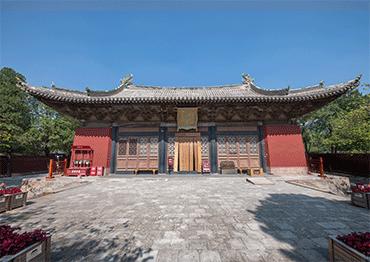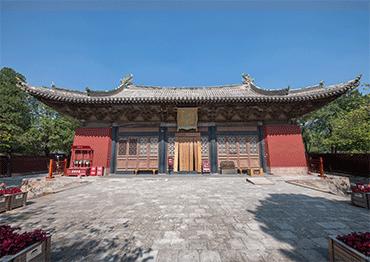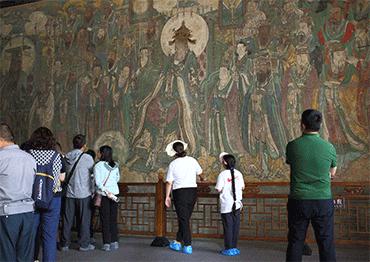At the exhibition, visitors can view a chiwen, a legendary animal-shaped ornament once perched on the roof ridge of Chunyang Hall that was removed during the mid-20th-century relocation of Yongle Palace. This glazed figure, made of red clay, stands 2.2 meters tall. Its exaggerated form conveys a powerful, intense energy.
The palace’s century-long construction was largely due to the painstaking process of painting its murals. In Chinese art history, these murals are seen as both a continuation and refinement of Tang and Song traditions. They are masterpieces of Yuan Dynasty Daoist art, embodying ideals of truth, virtue and beauty. Alongside the murals of the Dunhuang Grottoes, they are hailed as national treasures, earning Yongle Palace the nickname “Eastern Gallery.”
The murals serve as Daoist visual doctrine, designed to teach, inspire and awe. Their creation spanned nearly the entire Yuan Dynasty. More than 1,000 square meters of murals survive today, mainly within four Yuan-era halls: Longhu Hall, Sanqing Hall, Chunyang Hall and Chongyang Hall.
The murals in Longhu and Sanqing halls were executed with fine brushwork and vivid colors. They depict awe-inspiring scenes of guardian deities in cosmic landscapes, with celestial bodies such as the sun, moon and stars, and earthly features like mountains and rivers, woven into a Daoist vision of unity. Central to these scenes is Yuanshi Tianzun, the supreme Daoist deity, worshipped by a pantheon of divine figures.
By contrast, the murals in Chunyang and Chongyang halls adopt a blue-green landscape style and a narrative approach. They recount the lives of Lü Dongbin and Wang Chongyang, highlighting Daoist values such as punishing evil, upholding virtue, helping the needy and fighting corruption.
Among them, The Assembly of Immortals in Sanqing Hall stands as the most exceptional, an AI-assisted restoration and digital replica of which is featured in the exhibition. This enormous mural, covering nearly 430 square meters, spans the northeastern and western interior walls. It portrays 290 deities paying homage to Yuanshi Tianzun. Eight principal figures are three meters tall. Even the smallest celestial maidens stand 1.9 meters, larger than life.
Completed in 1325, the mural showcases sweeping composition, dynamic brushwork and deep, resonant color. It represents the zenith of Yuan mural art and is the largest known ancient Chinese figure painting, an essential chapter in global art history.
The most stunning feature of the mural, also known as Chaoyuan Tu, is its expressive detail. Each of the 290 figures has distinct facial features and expressions. Their attire and headwear are entirely unique – no two are the same. The deities reflect a broad human spectrum: various classes, temperaments, life stories and emotions. Across more than 400 square meters, hundreds of figures, vessels, cloud patterns and decorative motifs are drawn with fluid lines, showcasing the pinnacle of traditional Chinese linework.
Color is another highlight. Artists used a technique called “heavy color outline filling” – bold outlines are meticulously drawn with a fine brush and filled in with mineral pigments, such as azurite, malachite, cinnabar and ochre. The most supreme deities are emphasized with vivid reds and greens, delicate gilding and ornamentation such as flowing robes, pearls and jade. From afar, the mural is majestic in its visual impact. Up close, the intricate linework and finely painted garments reveal its full beauty. Thanks to the use of natural mineral pigments, the colors remain dazzling and majestic, even 700 years later.

 Old Version
Old Version

